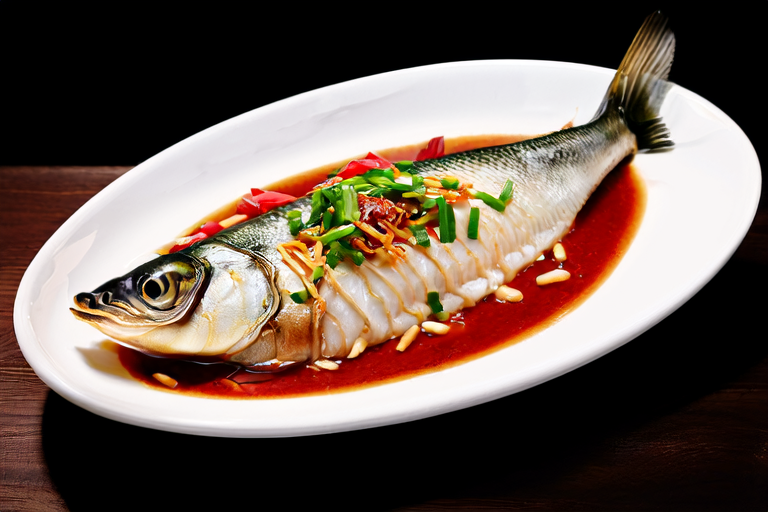Exploring the Flavors of Canton: A Traditional Steamed Sea Bass Dish
Introduction
Cantonese cuisine is renowned for its emphasis on freshness and delicate flavors. One of the most iconic dishes in Cantonese cuisine is steamed sea bass. This dish not only showcases the simplicity and elegance of Cantonese cooking but also highlights the importance of using high-quality ingredients. In this article, we will delve into the history, preparation techniques, and cultural significance of steamed sea bass, providing you with a comprehensive guide to creating this classic dish at home.
The History and Cultural Significance of Steamed Sea Bass
Steamed sea bass has been a staple in Cantonese cuisine for centuries. The origins of this dish can be traced back to the Pearl River Delta region, where fresh seafood was abundant. Cantonese chefs have long believed that the best way to prepare fish is by steaming it, as this method preserves the natural flavors and textures of the fish without overpowering them with heavy sauces or spices.
The cultural significance of steamed sea bass extends beyond its culinary appeal. In Cantonese culture, fish is often associated with prosperity and abundance, making it a popular choice for celebratory occasions such as weddings, New Year’s celebrations, and family gatherings. The practice of serving whole fish symbolizes completeness and unity, reflecting the values of harmony and togetherness that are deeply ingrained in Cantonese society.
Selecting the Right Ingredients
To prepare a truly authentic and delicious steamed sea bass, it is crucial to select high-quality ingredients. Here are some tips for choosing the best fish and accompanying ingredients:
- Fresh Sea Bass: Look for a firm, shiny skin and clear eyes. The flesh should be moist and elastic when gently pressed. It’s important to choose a fish that has been freshly caught and properly stored to ensure optimal flavor and texture.
- Vegetables: Common accompaniments include ginger, scallions, and garlic. These ingredients not only add flavor but also enhance the overall aroma of the dish. Choose fresh, vibrant vegetables that are free from blemishes or signs of wilting.
- Soy Sauce: Use a high-quality soy sauce, preferably one that is aged and made from natural ingredients. This will provide depth and complexity to the dish.
- Other Seasonings: Other essential seasonings include sesame oil, rice vinegar, and sugar. These ingredients help balance the flavors and bring out the natural sweetness of the fish.
Preparation Techniques
Preparing steamed sea bass requires attention to detail and precision. Follow these steps to ensure your dish is perfectly cooked:
- Preheat the Steamer: Start by preheating your steamer. If you don’t have a dedicated steamer, you can use a wok or a large pot with a steaming rack. Place the steamer over high heat and allow it to come to a boil.
- Prepare the Fish: Clean the sea bass thoroughly, removing any scales, gills, and internal organs. Pat the fish dry with paper towels and make several shallow cuts along the sides of the fish. This helps the steam penetrate the flesh evenly, ensuring that the fish cooks through without becoming too dry.
- Season the Fish: Rub the fish generously with salt on both sides. This step is crucial for enhancing the natural flavors of the fish and adding a subtle briny note to the dish.
- Add Garnishes: Arrange slices of ginger, scallions, and garlic inside the cavity of the fish. These ingredients not only infuse the fish with their aromatic flavors but also serve as a visual garnish, adding color and freshness to the dish.
- Steam the Fish: Place the seasoned sea bass on a heatproof plate or platter and place it in the steamer. Steam the fish for about 8-10 minutes, depending on the size of the fish. To check if the fish is done, insert a skewer into the thickest part of the fish; it should come out clean.
- Prepare the Sauce: While the fish is steaming, prepare the sauce. In a small bowl, mix together soy sauce, sesame oil, rice vinegar, and a pinch of sugar. Adjust the seasoning to taste, ensuring that the sauce is well-balanced and not too salty.
- Garnish and Serve: Once the fish is cooked, remove it from the steamer and drizzle the prepared sauce over the fish. Garnish with additional sliced scallions and a sprinkle of sesame seeds for added texture and color. Serve immediately while the fish is still warm.
Pairing and Serving Suggestions
Steamed sea bass pairs beautifully with a variety of side dishes and accompaniments. Here are some suggestions to complement your main course:
- Rice: Serve the fish with a side of steamed jasmine rice. The mild, fragrant rice provides a perfect contrast to the rich flavors of the fish and the savory sauce.
- Vegetable Stir-Fry: Prepare a quick stir-fry of seasonal vegetables such as bok choy, broccoli, or snow peas. Toss the vegetables in a light soy sauce and sesame oil for added flavor.
- Dumplings: Cantonese dumplings, either steamed or boiled, make an excellent accompaniment to the fish. They add a burst of flavor and texture to the meal.
Conclusion
Steamed sea bass is a testament to the artistry and precision of Cantonese cuisine. By following these steps and using high-quality ingredients, you can create a dish that not only satisfies the palate but also honors the rich culinary traditions of Guangdong province. Whether you’re celebrating a special occasion or simply enjoying a quiet evening at home, this classic dish is sure to impress and delight your guests. Happy cooking!


